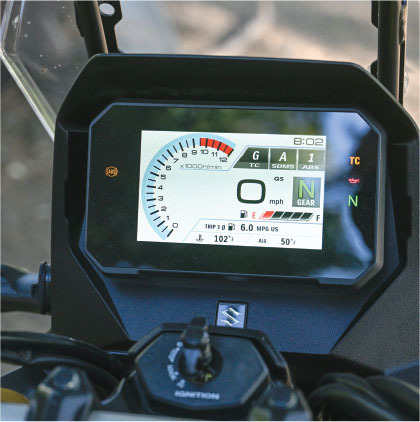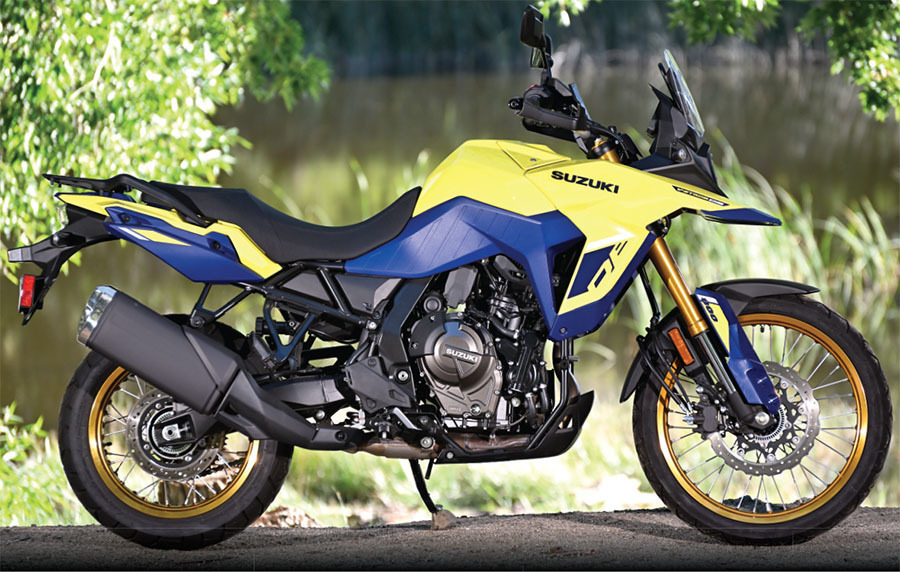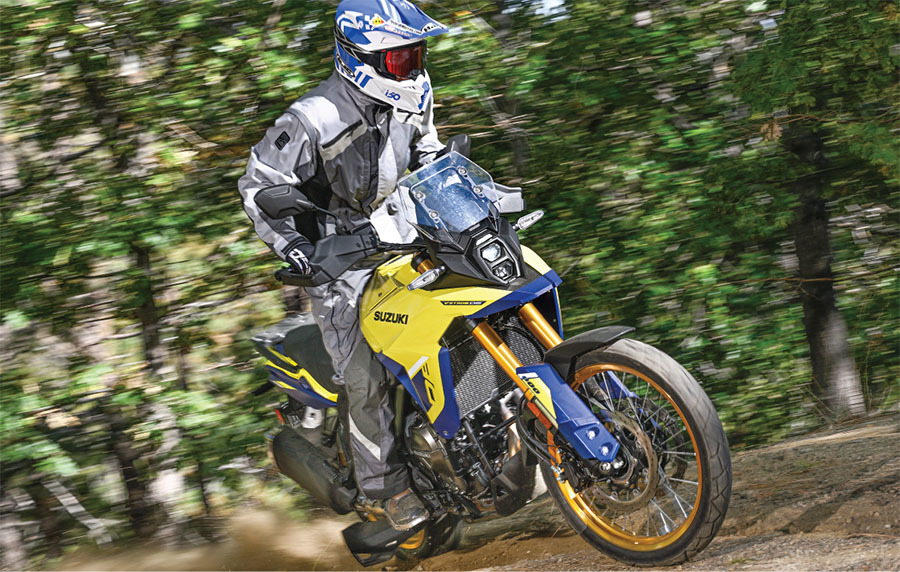Suzuki can stake a legitimate claim as co-creator of the adventure bike genre. Back in 1988, Suzuki Europe had the appropriately named “DR Big,” which was a 727cc single with a massive range and styling that paid tribute to the Paris-Dakar Rally. Over here, the V-Strom 650 sold in massive numbers starting in the early 2000s.
That’s why the new Suzuki V-Strom 800DE makes perfect sense as a cutting-edge adventure bike—only it’s 10 years overdue. The 800 picks up where the first V-Stroms left off. It isn’t a V-twin, though, and has no mechanical relationship to the existing V-Strom 1050 or 650. The motor is a 776cc parallel twin with a 270-degree crank. And, unlike the other V-Strom models, this one can take on the best in the adventure bike world.
A NEW TAKE ON AN OLD IDEA
Even though Suzuki was one of the first in the game, the V-Strom line had grown stale as far as true off-road capability goes. For Suzuki, the adventure bike title was code for any street bike with a relaxed riding position. Now, the biggest news is that the company is suddenly showing more commitment to off-road riding with a bike that’s new from the ground up in both design and concept. The motor was created to be used both in the V-Strom and in the GSX-8S naked street bike. The frame is like no previous V-Strom. It is constructed of steel rather than aluminum. The Showa suspension has more travel and more adjustability, the bike has more ground clearance and the electronic features show that Suzuki is paying attention. The V-Strom 1150 has had traction control since its introduction, but it was completely ineffective once you got off the pavement, acting more like a governor to prevent aggressive behavior. The 800, on the other hand, has three levels of traction control, plus “Gravel” mode that is configured to actually help you ride dirt roads more effectively, which is a complete 180 in philosophy. The bike’s electronic portfolio also offers options for the Suzuki Drive Mode System (SDMS), which is another way of saying power output. It has three levels: “A” is the most aggressive and “C” is for rain. And then there’s the anti-lock brake menu, which has two levels and “Off.” Even when Off is selected, some front-wheel anti-lock is noticeable, but only in a good way.


The Showa shock has adjustable compression and rebound, plus a hydraulic preload adjuster. If you want to stiffen it up for off-road riding, you don’t have to get out a hammer and punch; you just twist a knob by hand. The fork is fairly sophisticated compared to other bikes in this price range, with both adjustable compression, rebound and limited preload. It connects to a 21-inch front wheel with spokes and tube-type tires.
BIG ADVENTURE AND DAILY LIFE
The Suzuki is a comfortable bike. This is why adventure bikes like this have become popular for mainstream street riding; it’s spread out and puts the rider in a fairly upright riding position. And, there’s just enough wind protection to make that position workable at faster speeds on the street. The overall height is reasonable by adventure bike standards, too. A drop in the seat allows most riders to touch the ground flat-footed. When you get in the dirt, of course, that riding position can be awkward if you remain seated. You’re too far behind the big tank to properly weight the front wheel, which is why you must stand most of the time. That’s all normal adventure operating procedure. What sets the V-Strom apart is how well it fits in both environments. Once you’re standing, the riding position is perfect. The front wheel sticks, and the rear end breaks loose when you want it to. We have to confess that we never installed proper off-road tires in our time with the V-Strom. We stuck with the stock Dunlop TrailMax tires, which are 90 percent street-oriented. That meant we couldn’t get too wild in the dirt, but we were impressed by just how much we were able to get away with.
Our test bike is technically a 2023 model, but it’s mechanically identical to the 2024 version, which sells for $11,599.
The main attraction is the motor. The power on the Suzuki is great—smooth, long and revvy on top. Without a back-to-back comparison, it’s hard to say how well it compares to the BMW F850GS or the KTM 890 Adventure, but Suzuki claims 85 horsepower at 8500 rpm, which is a bit less than either of those but considerably more than a Yamaha T7 or the new Honda Transalp 750. It’s plenty, especially in the dirt. Without traction control, it’s fun to light up the rear wheel, but you don’t really go anywhere. The Gravel mode allows you to drift the rear wheel a little, but you also get decent drive. When you roll on the throttle, it smoothly limits wheelspin without any abrupt engine cut-out. When you choose higher levels of traction control, the motor seems to just slow down rather than cut out. That’s a huge step forward for Suzuki. This kind of traction control, as we mentioned, is actually designed to help you ride in the dirt rather than discourage you from even trying.

Any adventure bike is going to have to make compromises somewhere when it comes to suspension. Suzuki aimed the 800DE a little more towards the street side of the universe. That means it is a little cushier than either a KTM 890 or Yamaha T7. It’s more comfortable on the road that way, but when you find yourself going fast in the dirt, the front end will dive on braking more than you want, and you can use almost all the suspension in G-outs and washouts. Conversely, the Suzuki is more manageable at lower speeds, because it has a lower seat height and a lower center of gravity than either of those machines. It’s not light, by any means, but the crankshaft is reasonably low in the chassis compared to similar bikes. It gives up about 2 inches of ground clearance to the KTM and the Yamaha, but has more than the Honda Transalp.
Overall detailing is quite good on the 800DE. The foot controls have enough adjustment to work for both worlds. Even the footpegs have excellent grip once you remove the rubber inserts. The handlebar is oversize aluminum, it has good handguards and the fuel range is above average with its 5.3-gallon fuel tank.
The 800DE’s motor is a parallel twin with a 270-degree crank that mimics the pulse of a V-twin.
OFF-ROAD TOURING
There’s a sliding scale that we take for granted in the adventure bike world. On the far end we have full street bikes that are claimed to have mild off-road capabilities. The previous V-Strom offerings fell into that category. On the opposite side, there’s the KTM 890 Adventure R Rally Edition with its towering seat height and high-end suspension. The Suzuki falls right in the center. It’s more street-oriented than the Yamaha T7 and a little dirtier than the new Honda Transalp. We’re glad that Suzuki is back in the game, and especially impressed that it’s landed among such good company.









Comments are closed.